The sun gods of ancient religions
The sun gods of ancient religions
The sun gods of ancient religions
-
Hannah
-
Hannah
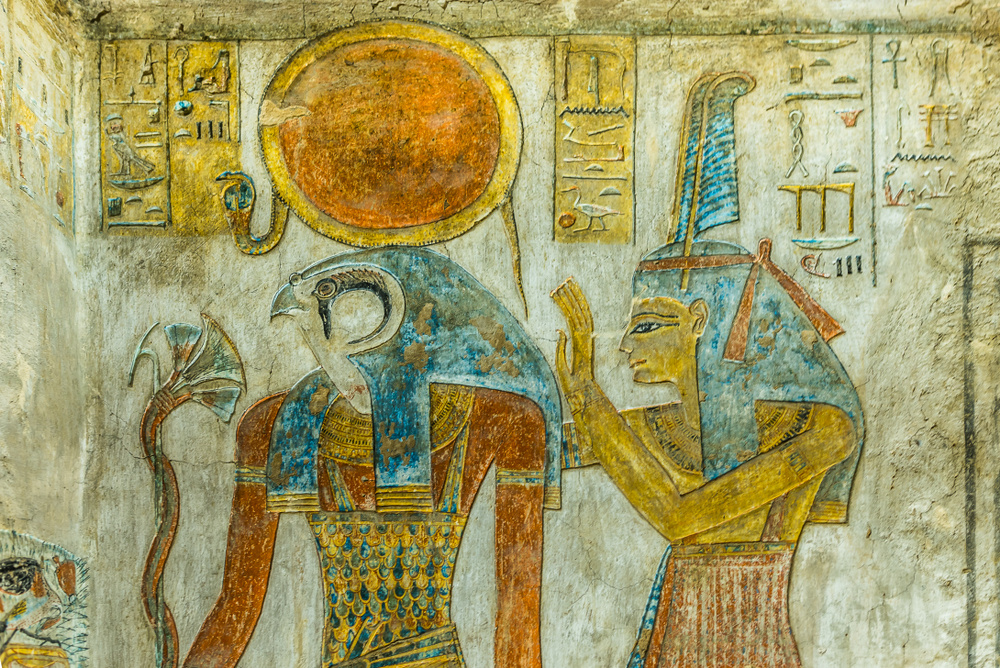
No doubt you know that ancient religions were usually polytheistic, meaning the people who followed the religion believed in and worshipped more than one god. Often there were gods for important aspects of life, like birth and death and love and war, and there were also gods for the natural world: for the sea, the sky, the sun.
What springs to mind when you think of an ancient sun god? I imagine you may think of a god who, it was believed, rode across the sky in a chariot, thus creating an explanation for people as to why each day the sun rose, moved across the sky and then set. One such god was from the Greek pantheon, and his name was Helios.
But there are many other sun gods besides, from those who were personified as the sun itself to those who were in charge of its great life-giving power. Here’s a look at some of the sun gods and goddesses who were worshipped in ancient times, starting with Helios and ending with Ra, the iconic Egyptian god.
Helios (Greek)
The weary sun hath made a golden set,
And by the bright track of his fiery car,
Gives signal of a goodly day tomorrow. – Richard III, Shakespeare
Helios – brother of the goddesses of the moon, Selene, and the dawn, Eos – was the personification of the sun. According to legend, each day he rode a chariot pulled by the fiery horses Pyrois, Aeos, Aethon and Phlegon across the sky from sunrise to sundown. In art, he was depicted with a crown of sunbeams.
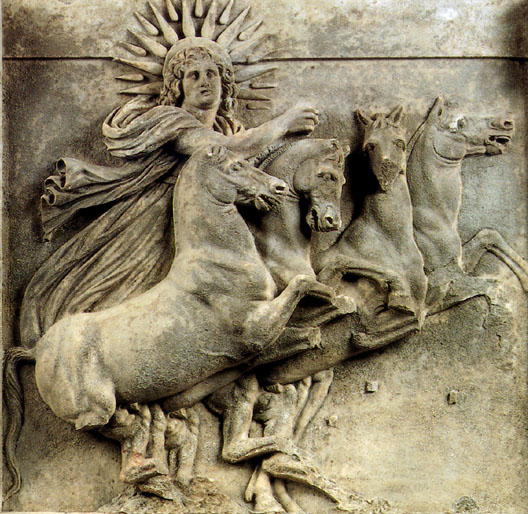
Helios relief, Temple of Athena, Troy
Sol (Roman)
Perhaps surprisingly, Sol was not as major a god for the Romans as Helios was for the Greeks. Some experts think there were two sun gods at different times in Roman history: first Sol Indiges (the deified sun) and then Sol Invictus (the unconquered sun). To this day in some Romance languages you can see the connection with the sun god in the word for sun: sol in Spanish and Portuguese, soleil in French, sole in Italian. Of course, the English word solstice is also associated with the Roman sun god; we know that on the 25th of December some Romans celebrated the winter solstice with the festival Dies Natalis Solis Invicti (Birthday of the Unconquerable Sun).
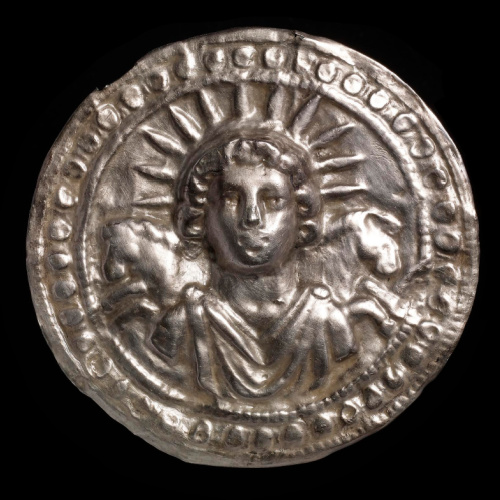
Silver disc featuring Sol, third century, British Museum, London
Sol (Norse)
Sol was the goddess of the sun, and she was the sister of Mani, the god of the moon. Together, they rode through the sky on chariots guiding the sun and moon on their paths. According to myth, they had to ride quickly, because they were pursued by two wolves named Skoll (‘Mockery’) and Hati (‘Hate’). It was foretold that someday the wolves would catch up with Sol and Mani, and the deities would be swallowed up as part of Ragnarok, the terrible battle between good and evil.
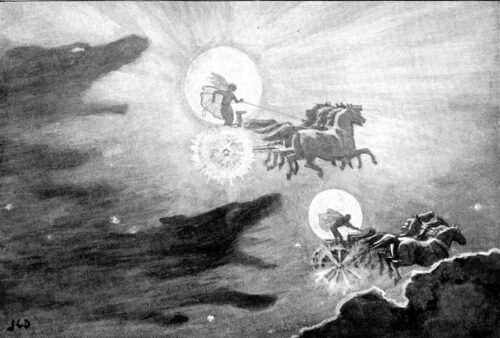
The Wolves Pursuing Sol and Mani by J.C. Dollman (1909)
Inti (Incan)
The Incans believed that their sun god, Inti, was their ancestor; according to one myth, Manco Cápac, the founder of the Incan civilisation, was Inti’s son. Inti’s sister and consort was Mama Quilla, the goddess of the moon. The Incans took worship of their sun god very seriously, for they relied on the sun to grow their crops; they would leave offerings for Inti at dedicated sun temples. Inti was depicted with a human face – showing his role as ancestor – surrounded by sunrays. To this day his image can be found in symbols of countries that once belonged to the Incan Empire; for example, you’ll find Inti on the flag of Argentina.
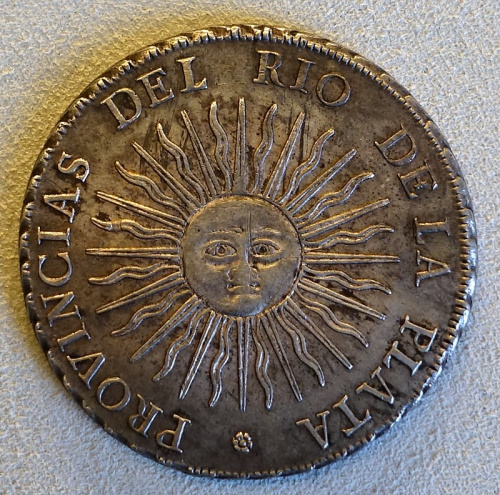
Depiction of Inti on a disc, Bode-Museum, Berlin
Huitzilopochtli (Aztec)
The Aztecs called themselves the people of the sun, meaning they were the people of Huitzilopochtli, their god of the sun. A ferocious deity, he was also the god of war. According to an Aztec legend, Huitzilopochtli was wronged by his siblings before he was born: they planned to kill him. He burst from his mother’s womb and killed his sister (who became the moon) and then chased his brothers, who scattered and became the stars. Huitzilopochtli, burning with rage, became the sun, and since then he has continued to chase his brothers and sister across the sky.

Huitzilopochtli depicted in the Codex Borbonicus, written by Aztec priests
Ra (Egyptian)
Ra, god of the sun, sailed across the sky in a solar barque (boat). He was a very important deity, the god of order, kings and the sky. He was the first god, alone in the primordial waters of Nun, and it was he who created everything; hence he was revered as the King of the Gods. He ruled over all: the sky, the earth and the underworld. He was often depicted with the head of a falcon and with a solar disc representing the Eye of Ra, a powerful symbol charged with the destructive force of the sun that could be used for protection.
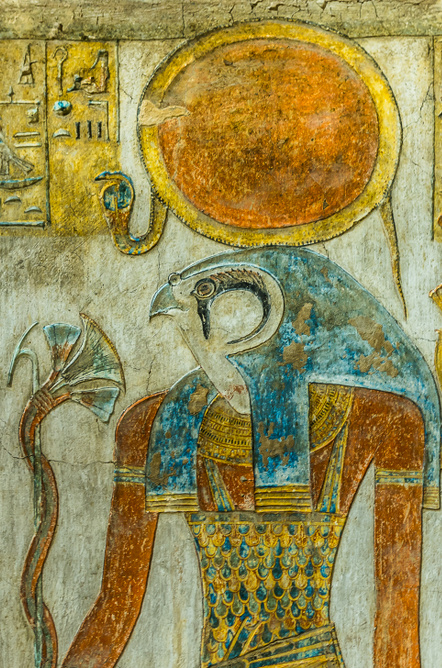
Ra depicted in the tomb of Tausert and Setnakht, Valley of the Kings, Luxor
Photo credits: 1) Stig Alenas/Shutterstock; 2) Gryffindor/Wikipedia; 3) British Museum; 4) public domain/Wikipedia; 5) public domain/Wikipedia; 6) public domain/Wikipedia; 7) Stig Alenas/Shutterstock.